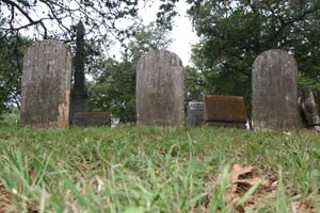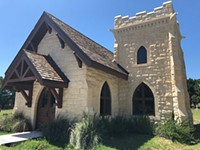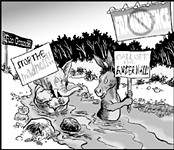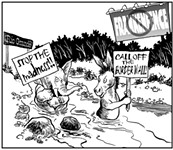City of the Dead
Journeying through the graves of Austin's oldest cemetery
By Cheryl Smith, Fri., April 21, 2006

I see you standing on the other side.
I don't know how the river got so wide.
I loved you, I loved you way back when –
And all the bridges are burning that we might have crossed,

but I feel so close to everything that we lost –
We'll never, we'll never have to lose it again.
So I bid you farewell, I don't know when I'll be back
They're moving us tomorrow to that tower down the track
But you'll be hearing from me, baby,

long after I'm gone.
I'll be speaking to you sweetly from my window in the Tower of Song.
– "Tower of Song" by Leonard Cohen
Used to be that when a pauper died in Austin, the city would send for an undertaker, and the undertaker would take the corpse by wagon over to what is now Oakwood Cemetery. The horses would trot up either to the north gates – they no longer exist – or to the gates on 16th Street, a mere block east of East Avenue, which would one day become part of I-35 – and the undertaker would unload the body and leave it on the ground. The north and west gates were the main entrances to City Cemetery – renamed Oakwood on City Cemetery in 1907 by council ordinance – Austin's first city-owned burial grounds as of the mid-1850s, the exact date unknown.
In 1914, the city built a vault for holding bodies inside the cemetery's little, wooden mortuary chapel. The storage space was much needed, as graves were dug by hand, taking hours of time and effort and making it impossible to put a body six feet underground efficiently. Those were also the days before widespread funeral homes, when people were more likely to die at home in bed than at a hospital. Corpses usually traveled directly from home to the cemetery.

Photo: Pica 03145 Austin History Center
Like all cemeteries, Oakwood's 40 acres mirror their inhabitants' living societies. In the cemetery's early days, the north section was designated as "colored grounds." Paupers' bodies were carted from the gate to a small plot in the northwestern portion of the cemetery, then buried in unmarked graves. And if you had a family and you weren't black or Latino, you were buried on the south side, with some sort of grave marker – perhaps just a plain, wooden remembrance, or maybe a fancy, carved or cast tombstone. Here is the tall "white bronze" (that is, cast zinc) marker of brother and sister Robert and Mable Tumey, who, according to the Austin Daily Statesman, died seven days apart in 1888 of diphtheria:
"Robert Homer Tumey, aged 2 years, infant son of Mr. and Mrs. William Tumey, after a brief illness with diphtheria, passed over the river into the realms of infinite peace and goodness, where, among the blessed of all worlds, he will be at rest and know no sorrow, no pain, no grief, forever and forever."
The paper wasn't quite as gentle in breaking big sister Mable's passing to readers, blurting "The Grim Reaper. Death has again invaded the household of Mr. and Mrs. William Tumey." This bluntness reflects the fact that death was a more commonplace part of everyday life than it is now. Local genealogist Danny Camacho, whose research greatly informs this story, recalls his aunt recounting what it was like in 1918, when the Spanish Flu pandemic hit Austin. Hearses, she told him, had a consistent, looming presence on the city's dirt roads – effectively doubling as ambulances, hauling bodies from home to embalmer to cemetery. "So many people were dying daily that they were a common site on the streets," said Camacho, aged 60, who knows the history of Oakwood as well as anyone.
Pre-Civil Rights Movement, if you were "colored" – black or Latino, aka "Mexican" – the plot your family bought at Oakwood would have been on the north side and was most likely marked by a small, plain tombstone, a wooden cross, or a single plank rising up from the earth. A Feb. 3, 1902, newspaper article about the funeral of Elizabeth Evans Garland illustrates the social divisions. Evans Garland had at one time been a teacher at the nation's first Freedmen's school for blacks – the first of thousands to spring up throughout the South after the Civil War. "The west side of the auditorium was filled with a large delegation from Tillotson college. The center of the church was given to the Mexicans, the younger pupils of the school taught by the deceased sitting near the coffin as chief mourners, while the east side of the church was filled with white friends."
Defending the Dead
Fast forward about a century. Sixteenth Street still runs down the center of Oakwood, all the way to Comal – which separates the main part of the cemetery from its more than 90-year-old, 18-acre annex – but the once-dirt road has long since been paved. There are even 15-mph signs on 16th near the cemetery's east- and west-end entryways – the only two the grounds have these days. The sign on the west end is accompanied by a nearby state historical marker, as well as a wooden "No Pets" sign, not that anyone pays it much mind. Oakwood now serves as de facto park for Swede Hill and other nearby neighborhoods, and neighbors take the approximate mile-long walk through the cemetery all the time. Oftentimes they bring along their dogs, which if leashed aren't a problem.

Thirty-seven-year-old Adrea Craft lives a couple of blocks from Oakwood and almost daily walks her two dogs, Cosmo and Rufus, up and down the worn dirt maze of shaded sand- and gravel-sprinkled paths running between uneven rows of graves in the older part of the cemetery. Craft gets mad when she sees dogs running loose through the tombstones and has complained on comment sheets found in clear boxes by the bulletin board in front of the moratorium chapel, now used as a one-man information office. The sheets are courtesy of Save Austin's Cemeteries (www.sachome.org) – a 2-year-old nonprofit organization, founded to raise money to maintain local cemeteries, as well as to raise awareness about their historical value. When Craft sees a loose dog's owner, she doesn't hesitate to tell him or her to put the pet on a leash, as she takes personal offense to roaming dogs "doing whatever to whatever headstones they come across. It seems like there is so little respect for the people who are interred there. ... I guess I'm kind of Don Quixote with this dog leash thing." People generally haven't responded well to her admonishments. "I've been flipped off. I've been called names. I've been told to mind my own business," said Craft, who has lived in the neighborhood seven years and says the cemetery's loose dog population has significantly increased. She attributes this to the changing landscape of Central East Austin – small, old houses getting torn down and replaced with large ones that almost completely fill up the area's tiny lots. The occupants of these new homes "just take their dogs over there to let them run around," she said.
Craft's personal admonishments are about the extent of rule enforcement at Oakwood. Austin's Public Safety and Emergency Management Department, which includes parks police, is responsible for patrolling the five cemeteries the city owns, "along with the 300 parks, and hike-and-bike trails, and all the lakes, and 21 recreation centers," as Lt. Frank Creasey put it. In other words, the department has a lot of green to cover. "Every once in a while I see a police car go through here," said David Camarillo, who mans Oakwood's tiny chapel office.
No cars patrol the cemetery at night because the gates are closed, but that doesn't mean much. Hookers and their johns are known to jump a low stretch of the fence near the west entrance after dark, as are drug users. Craft says she's come across needles and condoms more than once. Jim Stasswender, whose family has lived in Swede Hill since 1915, said he even used to jump that stretch of fence when he was a kid growing up in the neighborhood, as the cemetery functioned as a neighborhood playground – at least as far as he and his friends were concerned. Stasswender's family has owned Stasswender Memorials since 1915 – partially run for the past several years out of a nearly 100-year-old dilapidated wooden building on the corner of 16th right in front of Oakwood, tombstones covering the front yard. He says he's seen a lot of prostitutes and drug users on his stretch of 16th over the years but adds that the area has mellowed in recent times. He attributes this partially to the huge DoubleTree Club Hotel that in 1996 was built in the largely vacant and run-down land across the street.
"It Needs Work"
Although Central East Austin may be changing, fussing over Oakwood's treatment is nothing new. An April 12, 1901, headline in the Austin Daily Tribune reads, "Flowers Stolen From Graves," above the report "that for some time past the worst kind of vandalism has been committed in broad daylight at the city cemetery. Floral designs and other decorations have been stolen from a number of graves." In "Vandalism Told to City Council," in the Oct. 1, 1937, issue of the Austin American, a man complains to council members about a monument to his father being "marred by 'boys chunking rocks at it and chipping it.'" The more things change ... – just last year, some antique fencing was stolen from the oldest sections of the cemetery. (The thief was caught and jailed, and most of the fencing was recovered.)
Maintenance concerns have also been a long-running Oakwood theme. Stasswender, now 58, remembers the older sections of the cemetery being overgrown with tall grass and weeds, out-of-control ivy spreading over graves, and vines and gourds "all over the place" when he played on the grounds as a child in the 1950s. (He also recalls playing war, Tarzan, hide-and-go-seek, and other games with neighbor kids amongst the graves, hiding from the sexton all the while – "He used to give us hell all the time" – but says he knew better than to mess up anyone's burial spot. "My daddy would have skinned me alive.") A July 20, 1966, photo in the Austin American shows a section of the cemetery covered with weeds and high grass. The caption reads, "mowing crews level the little jungle about twice a year."

Part of the difficulty in maintaining Oakwood lies in the fact that, although the city owns the property, caring for individual plots is the responsibility of the families of the people buried in them. As Jay Stone, manager of Austin Parks and Recreation's financial services division, put it, "It's no different [from] when you purchase your home. You do the upkeep." Oakwood – and the city's four other cemeteries – are like their own neighborhoods within the city. Think of the plots as people's lots, the graves and mausoleums as people's houses, and the tombstones and other markers as fences (hence references to the cemetery in old newspapers as "The City of the Dead"). The hole in this rationale, says Dale Flatt, president and co-founder of Save Austin's Cemeteries, is that many of the families of people buried in Oakwood have long since moved away. In terms of long-term care, those graves have essentially become abandoned houses.
"I always assumed that Oakwood was very well taken care of," said Flatt, who first started going to the cemetery a few years ago to take photos. He's a firefighter by profession but got into photography after buying a fancy camera. The first time he went out to Oakwood there had recently been a bad storm that uprooted trees all over the grounds. The fallen trees prompted him to start asking around about Oakwood and its maintenance. He learned through his inquiries that the Parks and Recreation Department has contracted out management of Austin's city-owned cemeteries to San Marcos-based private firm Intercare Corporation since 1990. (PARD became responsible for the city's cemeteries in 1986; the Public Works Department managed them prior to that.) "When they privatized, a lot of things that normally would have been done, like the trees, just weren't written into the contract," Flatt said.
He also learned that the city doesn't budget anything for cemetery maintenance. Instead, maintenance is paid for through plot sales at Evergreen and Austin Memorial Park, the only two city cemeteries that still have space for sale. When someone buys a plot, they're buying it from the city, and the city uses that money to pay Intercare, Stone said. Plot sales from the two cemeteries total about $650,000 a year, he said, and $10,000 a year in taxes goes toward the five cemeteries. That's not a whole lot of green for five cemeteries, especially when one of them is 40 acres, with a significant number of its graves more than 100 years old. As Flatt put it, "Everybody knows it needs work, but it all comes down to money." That's why one of Save Austin's Cemeteries focuses is getting grant money to help maintain Oakwood.
Visiting Family
As it turns out, Austin's City of the Dead has no master plan. That's one of the main focuses of Save Austin's Cemeteries, of which Danny Camacho is one of about 30 members. He has six relatives buried in Oakwood, so he feels particularly invested in the group's master-plan goal. The bones of his great-granduncle, a set of great-grandparents, a set of grandparents, and a grand uncle are all in the cemetery's soil. He has yet to find a record of location for two of them, but the four graves he knows are on the north side along the fence line, across from UT's Disch-Falk baseball field. Minorities were typically buried along the perimeter of Oakwood's north side, he said. "We always got pushed to the edge one way or another."
As a Mexican-American, Camacho grew up visiting relatives at the cemetery. In his culture, "You come and visit the dead. Family is still around – they're just at the cemetery," he said, during a recent walk through the oldest parts of the cemetery, leaves crunching under the walking stick he uses, breaking up the steady, soft whoosh coming from vehicles speeding up and down I-35. He pointed out the markers with water damage, the monuments missing pieces, the overgrown tree branches choked with ball moss and on the verge of falling on century-old, hand-carved markers.
"A cemetery isn't just a burial place for dead people," he said. "In its own way, it's very much alive. These are people who have been alive as long as my family was in town. It's almost like time travel." ![]()
Cheryl Smith also wrote about the Austin State Hospital Cemetery in "In Memoriam," News, May 27, 2005.
Got something to say on the subject? Send a letter to the editor.










